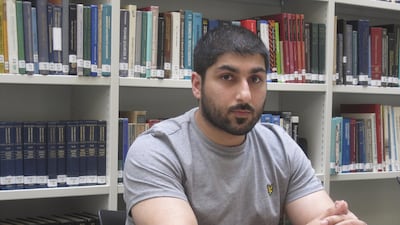Graphene, a material made up of a single layer of carbon atoms in a hexagonal lattice, was first observed under the electron microscope more than half a century ago.
It is little more than a decade, however, since this substance was properly isolated and described scientifically, an achievement that led, in 2010, to the awarding of the Nobel Prize in Physics to the two researchers responsible.
Properly characterising graphene was considered such a major step forward because of the remarkable properties this material displays: it conducts heat and electricity well and is about 200 times stronger than steel. That opens up a raft of potential applications that could transform many fields of technology, from telecommunications to lighting.
Among those fascinated by graphene and its uses is Ibrahim Ahmad, a 32-year-old Emirati. His interest in the subject took him from the UAE to the United Kingdom and the University of Manchester, the institution where that Nobel Prize-winning work took place. There the Dubai native completed a master’s degree.
Then he transferred to the world-renowned university city of Cambridge where, in a PhD programme sponsored by Abu Dhabi National Oil Company, he is looking at how graphene could be used in the composites produced by the Adnoc joint venture Borouge, for which he works. Often supplied in the form of pellets, materials produced by Borouge are used in the car industry and other sectors.
The focus of Mr Ahmad’s work is on producing substances that happen to have an especially long name: multimodal hydrophobic polymer-graphene nanocomposites. However, the name is not as intimidating as it sounds: the key point is that these substances contain both polymers (large molecules made up of many smaller molecules joined together) and graphene. And the word nano is used because the composite’s grain size is counted in nanometres.
Mr Ahmad wants to understand how the polymer and graphene can be mixed together to produce substances useful for industry.
“My project is to find a solution for that … to try to mix them without changing the properties of both of them,” he said.
Graphene could be used in place of other carbon-based substances and, because of its impressive capabilities, it might be needed in much smaller quantities as an additive. Whereas some carbon substances might need to be used as 40 per cent of the final mixture, with graphene the figure might be only 5 to 10 per cent.
It is about two years since Mr Ahmad moved to Cambridge, where he carries out laboratory work in a number of departments scattered across a spacious modern district to the west of the old colleges for which the city is famous.
Abu Dhabi plays a vital role in his research, much of which is about characterising composite materials produced at an industrial-scale facility at the Borouge Innovation Centre in Abu Dhabi’s Sas Al Nakhl area. Graphene is sent over from Cambridge and used to produce the composites, which in turn go to Cambridge for analysis.
“We try to … use the polymer already engineered for composites. We don’t want to integrate any new system in the plant,” said Mr Ahmad.
The mechanical and thermal performance of the composites are among the parameters that are important to industry. For those composites used to produce pipes, ultraviolet radiation absorption is key, as UV can degrade outdoor pipes over time.
One reason why Mr Ahmad has been particularly keen to work on graphene is that it is the starting point for many of the other interesting forms of carbon that have also captured the interest of scientists - and the media - in recent years. Among these other types are carbon nanotubes, which are single layers of carbon formed, as their name suggests, into tubes, and fullerenes, which are ball-shaped structures also made up of single layers of carbon atoms hexagonally joined to one another.
“If I work on graphene, I will know other carbon nanocomposites, such as carbon nanotubes and fullerenes, because everything is based on graphene. They’re all graphene, but in a different shape. It’s like an open gate for the others,” he said.
Mr Ahmad’s path to Cambridge began with an undergraduate degree at UAE University in Al Ain, from which he graduated in 2008. He then spent a year involved with laboratory work for Dubai Police before switching to Borouge, which is a joint venture between Adnoc and Borealis, an Austrian company. With Borouge, he carried out work that was mainly technical and he also held a position that mixed his scientific expertise with marketing functions.
In 2014 he began work for a master’s degree at the University of Manchester, and earned a distinction for his dissertation. The plan had been to then return to Borouge but, instead, and with the support of his employer, he is continuing to study.
It seems as though this decision is likely to pay off. Results so far have been promising and Mr Ahmad says a paper is close to being ready to submit for publication. He predicts that the scientific community will be surprised at the results, given the difficulties experienced by some other research groups with similar ambitions. Some of these other research groups, he suggests, may not have been careful enough about which polymer they used.
His work could represent a step towards using graphene on a truly industrial scale, something Mr Ahmad would like to see happen in the UAE.
“There’s no large-scale plant for graphene but we’re preparing for that. I’ve seen a lot of patents for that. They’re waiting for an investor to open a large-scale plant,” he said.
“If you look at any innovation centre like MIT [the Massachusetts Institute of Technology], Stanford, Oxford - every university has a centre for graphene. Imagine how many people are working [on it] but we don’t have a factory for graphene. In Cambridge there’s one on a small scale. It’s my dream, to be honest, to have it in our country."


